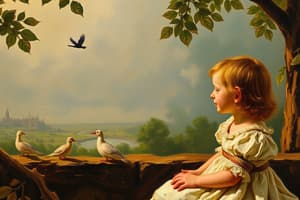Podcast
Questions and Answers
What does 'timbre' refer to in dance and music?
What does 'timbre' refer to in dance and music?
Timbre refers to the tone color or quality of the sound produced by instruments.
Describe what 'footwork' entails in dance.
Describe what 'footwork' entails in dance.
Footwork involves the position and movement of the feet during a dance routine.
What is the moonwalk and what illusion does it create?
What is the moonwalk and what illusion does it create?
The moonwalk is a dance technique that gives the illusion of being pulled backward while walking forward.
How does folk dance reflect the culture of its people?
How does folk dance reflect the culture of its people?
What characterizes ballroom dances?
What characterizes ballroom dances?
What role does music play in dance?
What role does music play in dance?
Explain how balancing and flexibility contribute to dance performance.
Explain how balancing and flexibility contribute to dance performance.
What is meant by 'hand hold' in the context of dance?
What is meant by 'hand hold' in the context of dance?
What is the primary difference between additive and subtractive sculptural processes?
What is the primary difference between additive and subtractive sculptural processes?
What is a mural and where is it typically applied?
What is a mural and where is it typically applied?
Define 'miniature' in the context of sculpture.
Define 'miniature' in the context of sculpture.
How does orientation play a role in sculptural design?
How does orientation play a role in sculptural design?
What does the term 'proportion' refer to in sculpture?
What does the term 'proportion' refer to in sculpture?
What are the characteristics of distance in painting?
What are the characteristics of distance in painting?
What is the purpose of composition in sculpture?
What is the purpose of composition in sculpture?
Describe the role of easels in painting.
Describe the role of easels in painting.
What does the term 'Digital Art' refer to in this context?
What does the term 'Digital Art' refer to in this context?
How does Edgar Degas' work, specifically 'Ballet Rehearsal', demonstrate the concept of motion?
How does Edgar Degas' work, specifically 'Ballet Rehearsal', demonstrate the concept of motion?
What is meant by 'Static' in art, and can you provide an example?
What is meant by 'Static' in art, and can you provide an example?
Define 'Passion and Dedication' in the context of artists' motivation.
Define 'Passion and Dedication' in the context of artists' motivation.
What role does observational skill play in the art-making process?
What role does observational skill play in the art-making process?
How can artists use their imagination to challenge limitations in their work?
How can artists use their imagination to challenge limitations in their work?
What does the phrase 'captures motion, energy' imply about certain artworks?
What does the phrase 'captures motion, energy' imply about certain artworks?
In what ways can themes in art reflect contemporary or futuristic ideas?
In what ways can themes in art reflect contemporary or futuristic ideas?
Flashcards
Digital Artists
Digital Artists
Artists who create art using digital tools and technology, often focusing on futuristic themes.
Dynamic Art
Dynamic Art
Art that captures movement, energy, or change.
Static Art
Static Art
Art that depicts stillness or stability.
Observational Skills
Observational Skills
Signup and view all the flashcards
Passion and Dedication
Passion and Dedication
Signup and view all the flashcards
Artistic Expression
Artistic Expression
Signup and view all the flashcards
Imaginative Artists
Imaginative Artists
Signup and view all the flashcards
Expressive Artists
Expressive Artists
Signup and view all the flashcards
Subtractive Sculpture
Subtractive Sculpture
Signup and view all the flashcards
Additive Sculpture
Additive Sculpture
Signup and view all the flashcards
Mural
Mural
Signup and view all the flashcards
Composition in Sculpture
Composition in Sculpture
Signup and view all the flashcards
Proportion in Sculpture
Proportion in Sculpture
Signup and view all the flashcards
Orientation in Sculpture
Orientation in Sculpture
Signup and view all the flashcards
Sand Sculpture
Sand Sculpture
Signup and view all the flashcards
Metal Sculpture
Metal Sculpture
Signup and view all the flashcards
Timbre
Timbre
Signup and view all the flashcards
Footwork in Dance
Footwork in Dance
Signup and view all the flashcards
Moonwalk
Moonwalk
Signup and view all the flashcards
Dance as Art
Dance as Art
Signup and view all the flashcards
Ballroom Dances
Ballroom Dances
Signup and view all the flashcards
Folk and Ritual Dances
Folk and Ritual Dances
Signup and view all the flashcards
Hand Hold in Dance
Hand Hold in Dance
Signup and view all the flashcards
Music in Dance
Music in Dance
Signup and view all the flashcards
Study Notes
4 Basic Relationships of Arts
- Subject Matter: Themes, topics, or elements represented in an artwork.
- Non-Figurative: Does not depict recognizable figures; often abstract.
- Figurative: Depicts recognizable figures.
- Universal: Broad themes like love, death, nature.
- Personal: Reflects the artist's experiences, emotions, or identity.
- Representation: A likeness of something.
- Representational: Subjects easily recognizable from the real world (e.g., portraits, landscapes, still life).
- Abstract: Subjects that do not directly resemble real things, focusing on shapes, colors, and textures.
- Symbolism: Using symbolic elements to represent deeper meanings (e.g., cultural, religious, or philosophical).
- Cultural and Historical Influences: Subject matter reflecting the time and place of its creation.
- Interaction with the Viewer: Engagement with specific subject matter.
Medium-Specific Considerations
- The medium of an artwork (painting, sculpture, digital art, etc.) affects the subject matter.
- Examples include: Paintings (landscapes, portraits), Photography (everyday moments), Sculptures (abstract forms), Digital art.
Elements of Painting
- Line: A narrow mark made by a brush or the meeting point of two objects; suggests movement.
- Shape: An enclosed area; can be geometric (triangle, square, circle) or organic (found in nature).
- Space (or volume): The area around a solid, balance between positive space (subject) and negative space (surrounding area).
- Texture: The surface quality of a painting.
- Composition: Arrangement of elements within a painting.
- Color (or hue): The most important element; sets the mood and feeling of the artwork.
- Tone or Value: How light or dark a color is without the color.
Elements of Sculpture
- Mass: The bulk or size of a sculpture.
- Space: The air around the solid object of a sculpture.
- Surface: Whether the sculpture is convex, concave, colored, uncolored.
Drawing
- Using tools like pencils, inks, or brushes to create an image.
Colors
- Primary: Red, Yellow, Blue.
- Secondary: Green, Orange, Purple.
- Tertiary: Yellow-orange, red-orange, red-purple, blue-purple, blue-green, yellow-green.
- Warm: Red, Yellow, Orange
- Cool: Blue, Green, Purple
- Analogous: Colors side by side on the color wheel.
- Complementary: Colors opposite on the color wheel.
Performing Arts
- Actors and Designers: Create the characters, visual aspects of the performance.
- Builders/Crews: Construct the sets, make costumes, handle props.
- Stage Managers: Runs the live production.
- House Manager: Admits and seats the audience.
- Playwrights: Write the scripts/plays
- Producer, Director
- Theatre is a collaborative art form involving actors, designers, builders, crews, stage managers, house managers, playwrights, producers, directors.
- Theatre refers to a performance, drama refers to the play.
Types of Dance
- Folk and Ritual Dances: Reflect the beliefs, interests, customs and practices of a specific ethnic group.
- Ballroom Dances: Performances usually in pairs (e.g. ballroom, nightclubs).
- Theatrical Dances: Performances for entertainment in a theater.
Instrumental Music
- Sonata: A long composition for a solo instrument.
- Suite: A series of musical pieces telling a story.
- Symphony: A sonata for an orchestra.
- Concerto: A sonata for solo and orchestra.
- Chamber Music: For two or more instruments.
Vocal Music
- Opera: Drama set to music (using actions, costumes, and scenery).
- Cantata: A story told in music without action; may be secular or religious.
- Oratorio: A form of dramatic music based on biblical or contemplative stories.
Music Classification
- Soprano, Alto, Tenor, Bass, Mezzo-Soprano
- Alto or Contralto
- Mezzo Soprano
- Lyrical Soprano
Studying That Suits You
Use AI to generate personalized quizzes and flashcards to suit your learning preferences.




